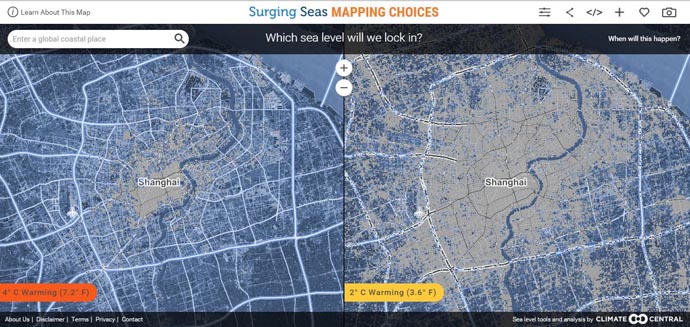Notes from COP 21: after the agreement
An historic agreement was reached in Paris on Saturday. One hundred and ninety-five nations agreed that we must reduce our greenhouse gas emissions and must work to keep the average global temperature rise to under two degrees Celsius (3.6 degrees F) from pre-industrial levels. Only one of the 196 nations attending, Nicaragua, objected on the basis that the agreement didn’t go far enough. At the strong urging of island states, the agreement also has an aspirational goal of keeping the increase under 1.5 degrees C, because, the island nations argue, many of them cease to exist with a rise in global average temps over 1.5. To understand graphically what these temperature changes mean to coastal cities, the research organization Climate Central has developed a tool called Surging Seas that compares the impact of different levels of temperature rise on coastal flooding.
This agreement is a major achievement and much credit goes to the thousands of negotiators, scientists, and politicians who did what many said was impossible – brokered an agreement among countries whose very existence is threatened by a lack of action and others whose economic livelihood or industrial development are dependent on fossil fuels. But there is still much work to do.
No matter what we do to cut carbon today, we are and will continue to feel the effects of climate change in all parts of the world for many years to come, and the nations have agreed to ramp up efforts to address this issue. The need to focus on climate adaptation – preparing for those impacts – is now, more than ever, critically important in rich and poor nations alike. You need only look at the Climate Central maps for any coastal city, and just the impact of 1.5 C will show that our cities are at risk. As more and more people move into the cities and we face the combination of sea level rise, more frequent and severe storms, and extended drought, we must prepare our infrastructure and other parts of our communities for these changes.
With the Paris agreement to reduce carbon emissions comes a commitment by the more wealthy nations to provide $100 billion a year toward climate adaptation support for poorer nations. How firm this commitment is and how quickly the money will flow is yet to be seen. There is already political posturing on both sides in the U.S. relating to public money for this effort, so it is clear that there is work to do. Regardless of the outcome of this debate, public funds can’t solve the entire problem. Much of our infrastructure is privately owned, and we need to make sure our cities and our industries are prepared for the changes that are coming. This is a problem that will require the public and private sectors to work together as we have seen many times in the past when we faced a major crisis. We have done it before and we can do it again.
Josh Sawislak is global director of resilience for AECOM.








